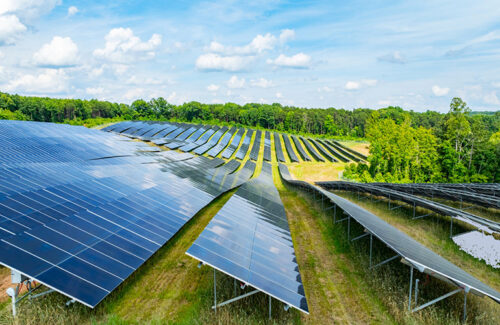Solar and wind accounted for almost 98% of new electrical generating capacity added to the U.S. grid in the first quarter of 2025 and were the only sources of new capacity in March. The SUN DAY Campaign reviewed data from FERC to find that March 2025 was the 19th consecutive month where solar was the largest source of new capacity.
In its latest monthly “Energy Infrastructure Update” report, FERC reported 31 “units” of solar totaling 446 MW were placed into service in March along with one unit of wind — the 223.9-MW Shamrock Wind & Storage Project in Crockett County, Texas. Combined, they accounted for 100% of all new generating capacity added during the month.
And for the first three months of the year, the combination of solar and wind (7,076 MW) was 97.8% of new capacity while natural gas (147 MW) provided just 2.0%, and another 0.2% came from oil (11 MW).
Solar accounted for two-thirds (66.6%) of all new generating capacity placed into service in March. For the first quarter, solar accounted for 72.3% of new capacity added. Solar has now been the largest source of new generating capacity added each month for 19 consecutive months: September 2023 through March 2025.
New wind accounted for the remaining third (33.4%) of capacity additions in March and provided over one-fourth (25.5%) of new additions for the quarter.
The installed capacities of solar (10.7%) and wind (11.8%) are now each more than one-tenth of the nation’s total. Taken together, they constitute almost one-fourth (22.5%) of the country’s total available installed utility-scale generating capacity.
Moreover, approximately 30% of U.S. solar capacity is in the form of small-scale (rooftop) systems that is not reflected in FERC’s data. Including that additional solar capacity would bring the share provided by solar and wind to more than one-quarter of the nation’s total.
With the inclusion of hydropower (7.7%), biomass (1.1%) and geothermal (0.3%), renewables currently claim a 31.5% share of total U.S. utility-scale generating capacity. If small-scale solar capacity is included, renewables are now about one-third of total U.S. generating capacity.
For perspective, a year earlier, the mix of utility-scale renewables accounted for 29.4% of total installed generating capacity, including solar (8.3%) and wind (11.8%). Five years ago, it was 22.7%; solar was 3.8% and wind was 9.0%. Ten years ago, it was 16.9% with wind at 5.7% and solar at 1.0%. Thus, over the past decade, wind’s share of U.S. generating capacity has more than doubled while that of solar has increased by more than ten-fold.
“Notwithstanding the Trump Administration’s anti-renewable energy efforts during its first 100+ days, the strong growth of solar and wind continues,” noted the SUN DAY Campaign’s executive director Ken Bossong. “And FERC’s latest data and forecasts suggest this will not change in the near-term.”
News item from SUN DAY



















